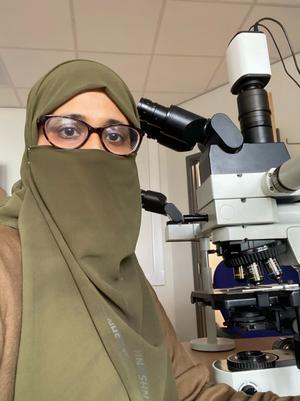Dr Aeman Khalid, Trainee Histopathologist
I developed a deep interest is pathology during my initial training in medical school in Aligarh, India. I remember one of my teachers telling us, as doctors we have to act as if it makes a difference and with pathology, it actually does.

Can you tell us what histopathology is?
In literal terms, the Greek word ‘Histopathology’ if disarticulated, is: histos- tissue, pathos- disease/suffering, logos- study in context. It is the examination of tissues under the microscope in order to diagnose various abnormalities like cancers and other conditions such as infections, inflammatory and autoimmune disorders.
It also includes studies to provide diagnostic and prognostic information or determine the cause of death.
Can you tell us about your average working day?
As a trainee my day begins at nine. Some days I start off by cutting up surgical specimens. Since I work at Royal Liverpool university hospital which is a tertiary care centre, there are specimens from a range of sub-specialities such as breast, gastro-intestinal, lung, skin, genito-urinary tract, etc. This usually takes from 2 to 3 hours depending upon the work load. After this, most of the day is spent on reporting- which includes initial screening/looking at the slides under the microscope on my own and formulating a report which are subsequently reviewed by the supervising consultant and finalised. I get plenty of breaks during these tasks to relax myself.
Apart from this, there are weekly multidisciplinary team meetings where we discuss the patients with our clinical colleagues. Also, there is a consensus meeting in most of the sub-specialities amongst the pathologists where we can discuss specifically difficult or unusual cases and reach a common consensus for the final diagnosis.
Mondays for us are usually the local or regional teaching days where we have at least 2 hours of dedicated teaching by the consultants.
I have done over 40 autopsies/post-mortem examinations during the first two years of my training. This is one optional domain of histopathology training, which we can either continue or drop after ST-2.
We also have frequent peer to peer teaching sessions, journal clubs and audit presentations where we discuss latest articles and have a check on our current practice.
What kind of work does your job involve?
Histopathology practice has many aspects that come in different flavours and challenges. Some of these include:
- Cutting up of surgical specimens (either the whole organs or little biopsies) and taking some representative portion to make glass side with stained tissues for examination.
- Looking at the slides under the microscope or at the digitally scanned images of the slides and finally writing up a report and reaching the final diagnosis in context of the clinical presentation.
- Autopsies/post mortem examination to identify the cause of death with a background of clinicopathological corelation.
- Audits, teachings, presentations and attending multidisciplinary team meetings are also part of my routine work.
Why did you choose this specialty?
Although I realised after working in histopathology that it has innumerable advantages as a career, there were two main reasons I chose it as a specialty to pursue:
I developed a deep interest is pathology during my initial training in medical school in Aligarh, India. I remember one of my teachers telling us, as doctors we have to act as if it makes a difference and with pathology, it actually does.
That was when I realised, without pathology, there is no medicine. It’s the never-ending enriching experience of trying to put the pieces of puzzle together to reach to a conclusion so as to contribute towards patient care. I must say it’s a truly rewarding specialty when what you see and say makes all the difference.
The other, very pertinent factor in this decision was the work-life balance. It’s a unique specialty that on one hand has the right blend of challenges to keep one busy and on the other hand gives one enough time and energy to focus on personal and social well-being.
What do you enjoy most about your chosen specialty?
I don’t have a dull moment as there is so much variety in the kind of work that I do. Each day is a new journey, a new challenge. The most interesting part is the clinical and pathological corelation. What the patient presents with is only half of the picture. We as pathologists complete the other half by digging deep and exploring the actual cause that led to this presentation. Getting surprises in what we find is not so infrequent and at times changes the entire perspective and the plan of management.
What do you find most rewarding about the role?
The most rewarding aspect is knowing that the correct patient care starts with my diagnosis-I am the actual driver behind the wheel! The sense of accomplishment that I feel when I take over the daunting task of giving the final verdict and seeing that translate into a targeted treatment plan, is a bliss.
What advice would you give to students looking to enter your field?
The pathologist is the only person who actually sees the patient like nobody else ever can.
Practicing pathology comes with responsibility and accountability. As much as it is fascinating to be the driver behind the wheel, you will be the one responsible for its safety as well. The right amount of passion and precision makes a good pathologist.
And here, I would also take the opportunity to defy one notion which puts many people off from pursuing pathology as a career- that pathologist doesn’t see the patient. In fact, I would say, the pathologist is the only person who actually sees the patient like nobody else ever can. Its only our own perspective, if we want to look at the glass half empty or half full.
If you want to be the backbone of medicine; join pathology!
